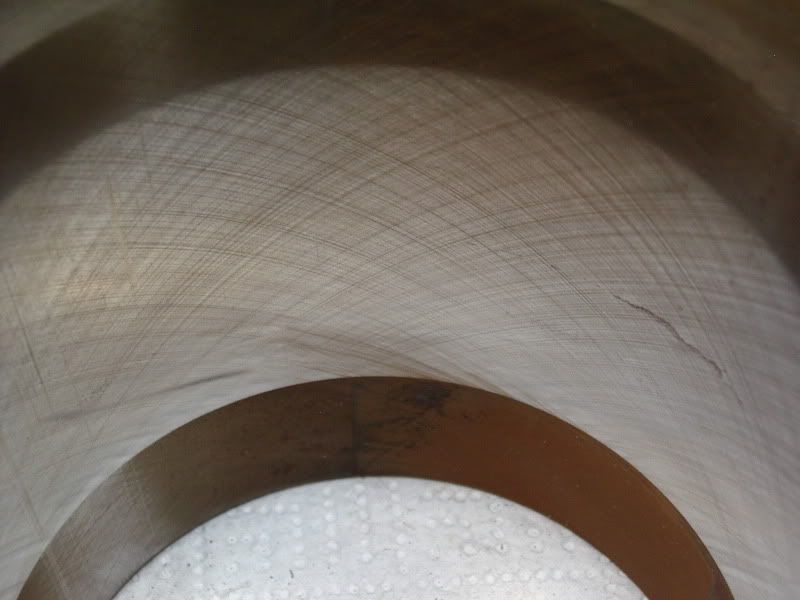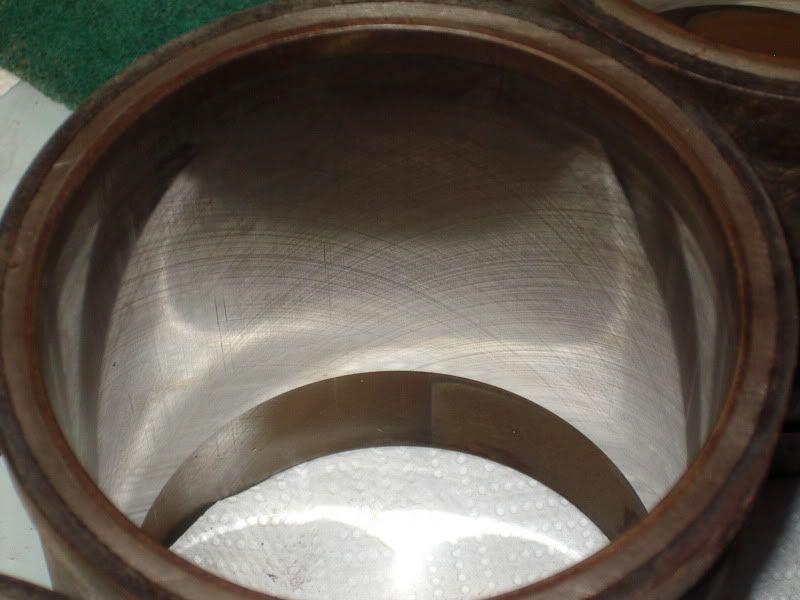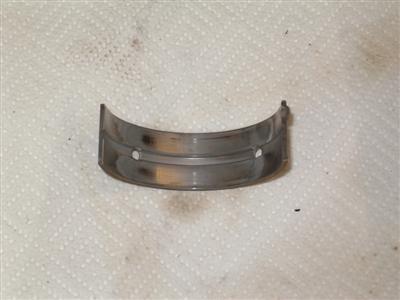While we're on the subject of bore honing...
Discussion
...I wonder if you guys could have a look at this.
Alfa v6 with 150k on the clock undergoing rebuild. I've measured the cylinder liners with a dial bore gauge and found:
What is confusing me is that there is virtualy no visible wear on the bores - the crosshatch is visible all the way down:


So my question is - can there really be so much wear without removing the honing marks? If not, it suggests that the bores were oval/oversized before honing.
Either way, I guess I'm looking at some new liners?
Alfa v6 with 150k on the clock undergoing rebuild. I've measured the cylinder liners with a dial bore gauge and found:
- two are out of round to the tune of 0.0125mm.
- All except one are oversized, the best being 0.001 and the worst, 0.011 over.
- Taper is however good in all cases, being at best zero, and at worst 0.005mm
What is confusing me is that there is virtualy no visible wear on the bores - the crosshatch is visible all the way down:


So my question is - can there really be so much wear without removing the honing marks? If not, it suggests that the bores were oval/oversized before honing.
Either way, I guess I'm looking at some new liners?
Puma is the man for this.
But those measurements you have given are incredibly small.
0.0125mm is like 0.5 thou ( 0.0005" ) which surely is well within any tolerances ?
Sounds like the bores are perfectly fine ? Certainly look fine.
And any discrepancies in measurements, may well be 100% when the head is torqued up.
But those measurements you have given are incredibly small.
0.0125mm is like 0.5 thou ( 0.0005" ) which surely is well within any tolerances ?
Sounds like the bores are perfectly fine ? Certainly look fine.
And any discrepancies in measurements, may well be 100% when the head is torqued up.
Edited by stevieturbo on Monday 5th July 11:13
The bores are certainly fine and a factory tolerance of 0.01mm is way smaller than most I have encountered. Usually -0.000"/+0.001" is about what you get which is 0.025mm.
Given that you don't know exactly what size the bores were when new you can conclude from the perfect honing marks that there is fact no appreciable wear whatsoever. A quite astonishing result for the mileage. In fact it begs the question what was wrong with it to make you rebuild it in the first place because it would certainly have carried on perfectly happily for a long long time.
Slap it back together quick and leave well alone.
Given that you don't know exactly what size the bores were when new you can conclude from the perfect honing marks that there is fact no appreciable wear whatsoever. A quite astonishing result for the mileage. In fact it begs the question what was wrong with it to make you rebuild it in the first place because it would certainly have carried on perfectly happily for a long long time.
Slap it back together quick and leave well alone.
They do seem very small tolerances don't they?
But here's the workshop manual:
(mine are class B):

The engine was running fine when I got it, so part of me just thinks "replace the bearings and rings and get on with it", but then I don't want to go to all the effort if I'm just putting badly worn bits back in.
But here's the workshop manual:
(mine are class B):

The engine was running fine when I got it, so part of me just thinks "replace the bearings and rings and get on with it", but then I don't want to go to all the effort if I'm just putting badly worn bits back in.
Pumaracing said:
The bores are certainly fine and a factory tolerance of 0.01mm is way smaller than most I have encountered. Usually -0.000"/+0.001" is about what you get which is 0.025mm.
Given that you don't know exactly what size the bores were when new you can conclude from the perfect honing marks that there is fact no appreciable wear whatsoever. A quite astonishing result for the mileage. In fact it begs the question what was wrong with it to make you rebuild it in the first place because it would certainly have carried on perfectly happily for a long long time.
Slap it back together quick and leave well alone.
Well that's put my mind at rest, thanks Given that you don't know exactly what size the bores were when new you can conclude from the perfect honing marks that there is fact no appreciable wear whatsoever. A quite astonishing result for the mileage. In fact it begs the question what was wrong with it to make you rebuild it in the first place because it would certainly have carried on perfectly happily for a long long time.
Slap it back together quick and leave well alone.

Nowt was wrong with it, it was coming apart because I'm having some larger valves and new cams put in, and I figured that it was worth a stripdown and refresh whilst I had it on the garage floor, in view of its long life.
The main bearing shells look pretty worn anyway, so replacing them is probably a good thing:

Actually that shell looks just fine. No scoring and it's not even worn through the top coating on the babbit material. However with the engine apart of course it would be false economy to reuse them.
As to the pistons and liners you can see from the max on grade C and the min on grade A what the actual production tolerances are - just over a thou as I suggested. Then what they do is grade the pistons and liners to get a closer match and certainly better than any engine reconditioner is going to give you.
I'd check the piston ring gaps in the bores and if they're still ok put them back in without honing the bores. If you change rings then a light hone would be advisable but then you run the risk of some idiot cocking that up. You can rarely beat OE manufacturing standards, or at least most people can't.
As to the pistons and liners you can see from the max on grade C and the min on grade A what the actual production tolerances are - just over a thou as I suggested. Then what they do is grade the pistons and liners to get a closer match and certainly better than any engine reconditioner is going to give you.
I'd check the piston ring gaps in the bores and if they're still ok put them back in without honing the bores. If you change rings then a light hone would be advisable but then you run the risk of some idiot cocking that up. You can rarely beat OE manufacturing standards, or at least most people can't.
Superb pictures of the honing btw. Could have done with those when I was trying to explain things in the other thread. Very interesting comparing them to the A series hand honing pics. You can see how coarse the actual machine honing is. Very few individual honing lines, each about 0.5 to 1mm apart but very clear and distinct, all exactly at the 45 degree desirable angle and looking like they were machined in with a diamond tool. In fact it's very likely they were actually done with a diamond hone rather than an oxide abrasive one which are largely superceded for production machining.
Compare with abrasive honed bores which have thousands of finer "scratches" and somewhat varying honing angles as it's being done by hand.
It goes to show how wide the variation on acceptable honing practice is, with coarse honing being better for long service life in road cars albeit perhaps with more running in being needed and fine honing for race engines that would be knackered already if you ran them in for 5000 miles before being able to thrash them.
I suspect that there was originally a lighter plateau hone on top of the coarse base honing and the marks of that are what have disappeared over time.
Anyway, glad to have been able to be of help.
Compare with abrasive honed bores which have thousands of finer "scratches" and somewhat varying honing angles as it's being done by hand.
It goes to show how wide the variation on acceptable honing practice is, with coarse honing being better for long service life in road cars albeit perhaps with more running in being needed and fine honing for race engines that would be knackered already if you ran them in for 5000 miles before being able to thrash them.
I suspect that there was originally a lighter plateau hone on top of the coarse base honing and the marks of that are what have disappeared over time.
Anyway, glad to have been able to be of help.
PS, I'd also check the vertical clearance of the piston rings in the ring grooves. Ideally as new this would be less than 2 thou with anything over 4 thou being considered as pretty worn. Some engines do wear their ring grooves even when everything else looks mint. Crank polishing and sizing you've already got information on in the A series thread. Anything else just ask and I'll help as much as possible.
Hope your modified heads work out ok. I daren't ask who you've decided to use in case the answer upsets me too much.
Hope your modified heads work out ok. I daren't ask who you've decided to use in case the answer upsets me too much.
Yup, I'd planned to check the ring clearances, though I was assuming that I may as well replace the rings anyway.
I didn't mention this before because my brain wasn't working, but I've just sent the pistons off to have larger valve cutouts machined in them. So it'll be a few weeks before I can do anything with them.
Head builder was recommended to me rather than using a pin in the yellow pages, but the proof is in the pudding...
I didn't mention this before because my brain wasn't working, but I've just sent the pistons off to have larger valve cutouts machined in them. So it'll be a few weeks before I can do anything with them.
Head builder was recommended to me rather than using a pin in the yellow pages, but the proof is in the pudding...
Gassing Station | Engines & Drivetrain | Top of Page | What's New | My Stuff



